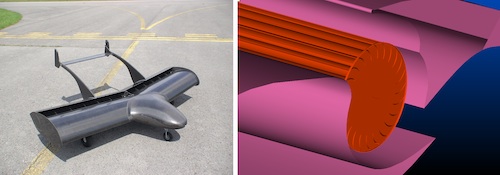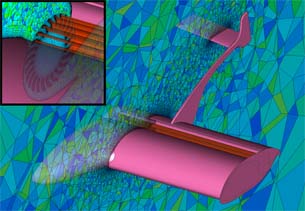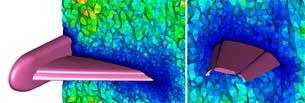Latest News
February 24, 2010
By DE Editors
Generating grids is an ugly business. And while it hasn’t gotten any prettier, it is getting easier, especially for engineers who are pushing the envelope to get maximum aerodynamic performance out of their machines. The new T-Rex technology from Pointwise, Inc., maker of CFD meshing software Gridgen and Pointwise, removes one of the biggest bottlenecks: quickly generating meshes for accurate CFD analysis.
 Figure 1: Left: Propulsive wing in flight test; Right: Embedded cross-flow fan. |
The complex problems engineers deal with on a daily basis continue to challenge the capabilities of both computing hardware and software tools. Meeting engineers’ needs while using an affordable amount of computing hardware requires that grids be packed or “clustered” in regions where the flow changes rapidly and coarsened where the flow is homogeneous. One region where the flow almost always experiences large changes is at the wall boundary or boundary layer. Best CFD practices suggest creating high-aspect ratio cells in the boundary layer where the cell length perpendicular to the wall can be tens or hundreds times smaller than the cell length along the wall.
Important for the Design
Propulsive Wing LLC is developing a new, patented aerodynamic platform that integrates an embedded, distributed cross-flow fan propulsion system within a thick wing (Figure 1).
 Figure 2: How long would it take you to generate a high quality grid for this application? |
It is a daunting task for any grid generator to capture small details in the fan region (Figure 1) embedded within the trailing edge of a large wing body while creating boundary layer cells. Because the aircraft’s performance is tightly coupled to the fan’s performance, accurately determining performance parameters—such as lift and drag as well as thrust and power—is crucial to the design. T-Rex technology was used to create a high-quality boundary layer mesh for this configuration with 25 layers of cells in the boundary layer and 5 million total cells (Figure 2). The entire grid was built in less than a day. Conventional meshers may take several days or weeks, if they are able to complete a mesh at all.
Advantages of T-Rex
T-Rex is a fast yet powerful technique that eliminates the drawbacks commonly encountered when meshing the boundary layer region for complex configurations. T-Rex achieves this by:
• Continually optimizing the mesh quality in difficult regions
• Automatically detecting grid collisions and compensating by stopping the inflation locally and continuing elsewhere
• Smoothly blending the boundary layer region with the far field.
 Figure 3: T-Rex grid around a full car body. |
A T-Rex grid around a detailed automotive model (Figure 3) demonstrates its capabilities. Underneath the vehicle, layers from the underbody and road surface inflating toward each other stop only where needed and continue to advance where there is room. The right image illustrates how T-Rex can control the layer inflation in sharp corners. Around the outer portion of the body, the boundary layer cells transition very smoothly into the far field. T-Rex performs all these steps automatically to ensure the grid is of the highest quality. Creating the quality of grid engineers demand on such models with traditional inflation techniques can be time consuming and often is not even possible.
How It Works
T-Rex does all this by combining traditional unstructured meshing techniques with the ability to create layers of thin, right angle tetrahedra. Thin, right angle tetrahedra are a desirable cell type for increasing flow solver accuracy and convergence rates. T-Rex begins with a triangulated surface mesh. It creates right angle tetrahedra by advancing layers on a point-by-point basis while evaluating a wide range of quality constraints and checking for the presence of points from adjacent layers. The point-by-point advancement is what gives T-Rex the ability to terminate layers locally, when necessary, while continuing elsewhere. Furthermore, T-Rex is closely coupled with the isotropic tetrahedral mesh, ensuring a smooth transition from the boundary layer to the far field.
 Figure 4: T-Rex grid on high-lift multi-element airfoil for the AIAA High-Lift Workshop. |
Fast and Accurate
Some of the most demanding computer aided engineering (CAE) applications come from the aerospace industry. As large computing resources become commonplace within this industry, the size and quality of the grids that aerospace engineers require is increasing commensurately. For example, aerospace engineers are using CAE to investigate non-cruise condition configurations, such as take-off and landing. While not nearly as important during cruise, high-lift devices, such as wing slats and flaps, play a critical role in determining the performance of the aircraft during take-off and landing. However, inclusion of these devices has long been a source of grid generation difficulty for engineers.
The AIAA High Lift Workshop, an industry-wide forum with the goal of enhancing CFD prediction capability for practical high-lift aerodynamics, used T-Rex to create a grid on its multi-element airfoil (Figure 4). Using T-Rex, grids that meet or exceed the strict meshing requirements of a benchmark such as the AIAA High Lift Workshop are possible in hours as opposed to days or weeks.
More info:
Pointwise
Subscribe to our FREE magazine, FREE email newsletters or both!
Latest News
About the Author
DE’s editors contribute news and new product announcements to Digital Engineering.
Press releases may be sent to them via [email protected].






